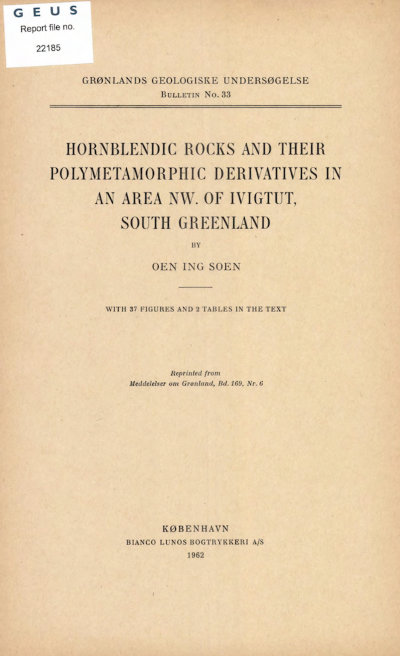Hornblendic rocks and their polymetamorphic derivatives in an area NW. of Ivigtut, South Greenland
DOI:
https://doi.org/10.34194/bullggu.v33.6567Abstract
Extensive zones of amphibolites and hornblendic rocks occur associated with biotite-plagioclase-quartz schists and garnet-biotite augen-gneisses, in the gneiss areas on NE. Tôrnârssuk and on the peninsula between Kuánit fjord and Tigssalûp ilua (Tigssaluk fjord) in SW. Greenland. Field and microscopic evidences show that these rocks have attained their present constitution mainly in the course of two metamorphic periods, referred to as the main and late-Ketilidian periods of metamorphism. The first period of metamorphism took place under amphibolite facies conditions and is believed to have caused the formation of extensive hornblenditic and amphibolitic layers. Hornblenditic rocks are now only preserved as relics enc10sed in rocks affected by the second period of metamorphism. The second period of metamorphism in the Kuánit area and on NE. Tôrnârssuk occurred under epidote-amphibolite facies conditions. In the Kuánit area a metamorphic differentiation due to differential shearing took place within the hornblenditic layers and resulted in the formation of banded hornblendic rocks, consisting mainly of alternating bands of epidote-hornblende schists, quartz-hornblende schists, magnetite-hornblende schists, and amphibolites, while at places of strongest shearing biotite-plagioclase-quartz schists and tremolite schists were formed. On NE. Tôrnârssuk biotite-plagioclase-quartz schists form more important zones or layers generally adjoining amphibolite horizons. Evidences are presented for the view that these schistose rocks are sheared and pegmatized, originally hornblendic rocks. The adjoining amphiholites are considered as feldspathized hornblendic rocks. The garnet-biotite augen-gneisses and amphibolites in the area south of Tigssalûp ilua are believed to have a similar origin as, respectively, the biotite-plagioclase-quartz schists and amphibolites on NE. Tôrnârssuk. Mineralogical differences are due to the higher grade of the second metamorphism, which reached amphibolite facies conditions in the Tigsalluk area. A third metamorphism during the Sanerutian period was apparently of a low grade or of a low intensity in the areas here under consideration, and it is not thought to have caused significant modifications in the rocks here described.
Downloads
Published
Issue
Section
License
This article is distributed under a CC-BY 4.0 licence, permitting free redistribution and reproduction for any purpose, even commercial, provided proper citation of the original work. Author(s) retain copyright over the article contents.


